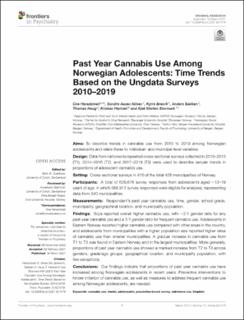| dc.description.abstract | To describe trends in cannabis use from 2010 to 2019 among Norwegian adolescents and relate these to individual- and municipal-level variables. Design: Data from nationwide repeated cross-sectional surveys collected in 2010–2013 (T1), 2014–2016 (T2), and 2017–2019 (T3) were used to describe secular trends in proportions of adolescent cannabis use. Setting: Cross-sectional surveys in 410 of the total 428 municipalities of Norway. Participants: A total of 628,678 survey responses from adolescents aged ∼13–19 years of age, in which 566,912 survey responses were eligible for analyses, representing data from 340 municipalities. Measurements: Respondent’s past year cannabis use, time, gender, school grade, municipality, geographical location, and municipality population. Findings: Boys reported overall higher cannabis use, with ∼2:1 gender ratio for any past year cannabis use and a 3:1 gender ratio for frequent cannabis use. Adolescents in Eastern Norway reported higher cannabis use compared with other areas in the country, and adolescents from municipalities with a higher population size reported higher rates of cannabis use than smaller municipalities. A gradual increase in cannabis use from T1 to T3 was found in Eastern Norway and in the largest municipalities. More generally, proportions of past year cannabis use showed a marked increase from T2 to T3 across genders, grade/age groups, geographical location, and municipality population, with few exceptions. Conclusions: Our findings indicate that proportions of past year cannabis use have increased among Norwegian adolescents in recent years. Preventive interventions to hinder initiation of cannabis use, as well as measures to address frequent cannabis use among Norwegian adolescents, are needed. | en_US |

